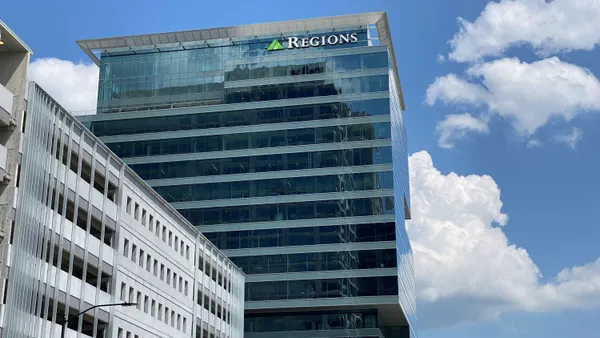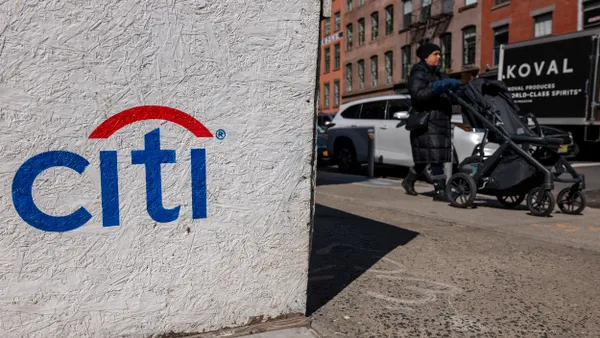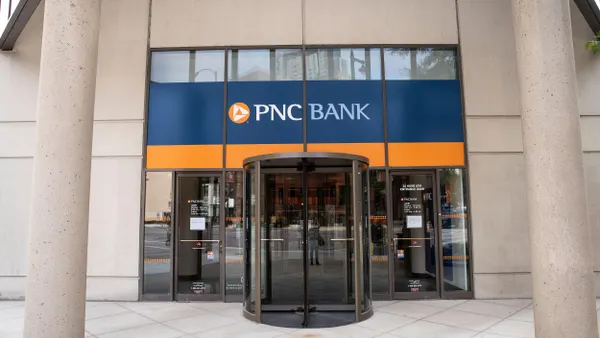Dive Brief:
- There were 68 bank mergers and acquisitions announced in the second quarter. That is down from 82 in the year-earlier period but up from 50 in the first quarter, according to S&P Global data. The vast majority of deals involved small banks (under $5 billion in assets) as the sellers.
- Bankers and analysts anticipate increased M&A activity as the year wears on because many community banks are grappling with high technology and funding costs, as well as fierce competition and pressure on loan yields. More of these banks could look to sell.
- Buyers are looming, too, as many regional banks are eager to gain scale and diversify their loan books and footprints through acquisitions.
Dive Insight:
The pace of bank M&A accelerated late in the second quarter and continued in the current quarter, with numerous deals announced during the summer months.
"Since June, there's been a lot more deals, and there are a lot of conversations going on that I think will lead to more deals in the second half of the year," Jacob Thompson, a managing director of investment banking at SAMCO Capital Markets, said in an interview.
Sellers are looking to join larger banks rather than try to keep pace with their technology spending amid broad competitive headwinds, Thompson said. The aim is to create more cost-efficient digital offerings and loan products for customers.
Elevated deposit costs, the result of Federal Reserve interest rate increases over the past two years, also have burdened community banks. Now, banks are bracing for new pressure on loan yields, after a Fed rate cut in late July. Floating-rate loans tend to reprice faster than banks can move on deposits, analysts said.
Larger community and regional banks, meanwhile, are eager to broaden their loan portfolios, giving them more options to grow interest income through loan volume — even as rate levels decline — and diversify to help safeguard credit quality should the economy slow and defaults rise on certain types of loans. If one or two loan categories generate losses but several others in a diverse portfolio persevere, a bank can profitably weather a recession, analysts said. Geographic diversity can prove similarly positive.
"So, M&A can be an efficient way to pick up significant earning assets to drive interest income, as well as more deposits to fund future loan growth and offset margin pressure," Jim Bradshaw, a bank analyst at Bridge City Capital, said in an interview. "And of course, as long as this economic cycle has been, banks are smart to brace for at least a mild recession."
Among the deals announced late in the second quarter: Wayne, New Jersey-based Valley National Bancorp ($32.5 billion in assets) plans to acquire Oritani Financial ($4.1 billion), based in the state’s Washington Township. The $740 million acquisition would double Valley’s presence in affluent Bergen County, and give it a new pool of potential borrowers and digital-product consumers. Because Valley has already invested in the development of digital offerings, it can deliver them at low cost to new customers.
The acquisition "is compelling for several reasons," Ira Robbins, Valley's president and CEO, said on a call to discuss the deal. "First and foremost, it accelerates our stand-alone strategic initiatives by growing our customer base, enabling us to leverage our technology investments and enhancing our efficiency ratio through significant cost savings."
In July, Wheeling, West Virginia-based WesBanco ($12.5 billion) inked a deal to help it expand into two high-growth markets, giving it important geographic reach at a time when West Virginia markets are not as vibrant. It said it would pay about $500 million to acquire Bowie, Maryland-based Old Line Bancshares ($3.1 billion), which has operations in the Baltimore and Washington areas.
"This merger will gain us entry into the two fastest-growing [metropolitan statistical areas] in the Mid-Atlantic region … both of which have great demographics and growth prospects," WesBanco President and CEO Todd Clossin said on a call to discuss the deal.
Pine Bluff, Arkansas-based Simmons First National Corp. ($17.9 billion) said it would diversify its loan books and pick up a substantial deposit base to fuel ongoing loan growth with its planned $435 million acquisition of Columbia, Mo.-based Landrum Co., the parent of Landmark Bank ($3.3 billion).
Landmark has $3 billion in deposits and a relatively low concentration in commercial real estate (CRE) loans. Simmons is working to lower its concentration risk in CRE and spread its tentacles into other areas of business lending.
"We're optimistic that a larger balance sheet and additional products and services will provide future revenue gains," Simmons Chairman and CEO George Makris said on a call to discuss the deal.
One way or another — greater technology, new business lines or new markets — banks are prioritizing diversification and viewing M&A as an efficient route. "No question, it is driving a lot of deals," Thompson said.












